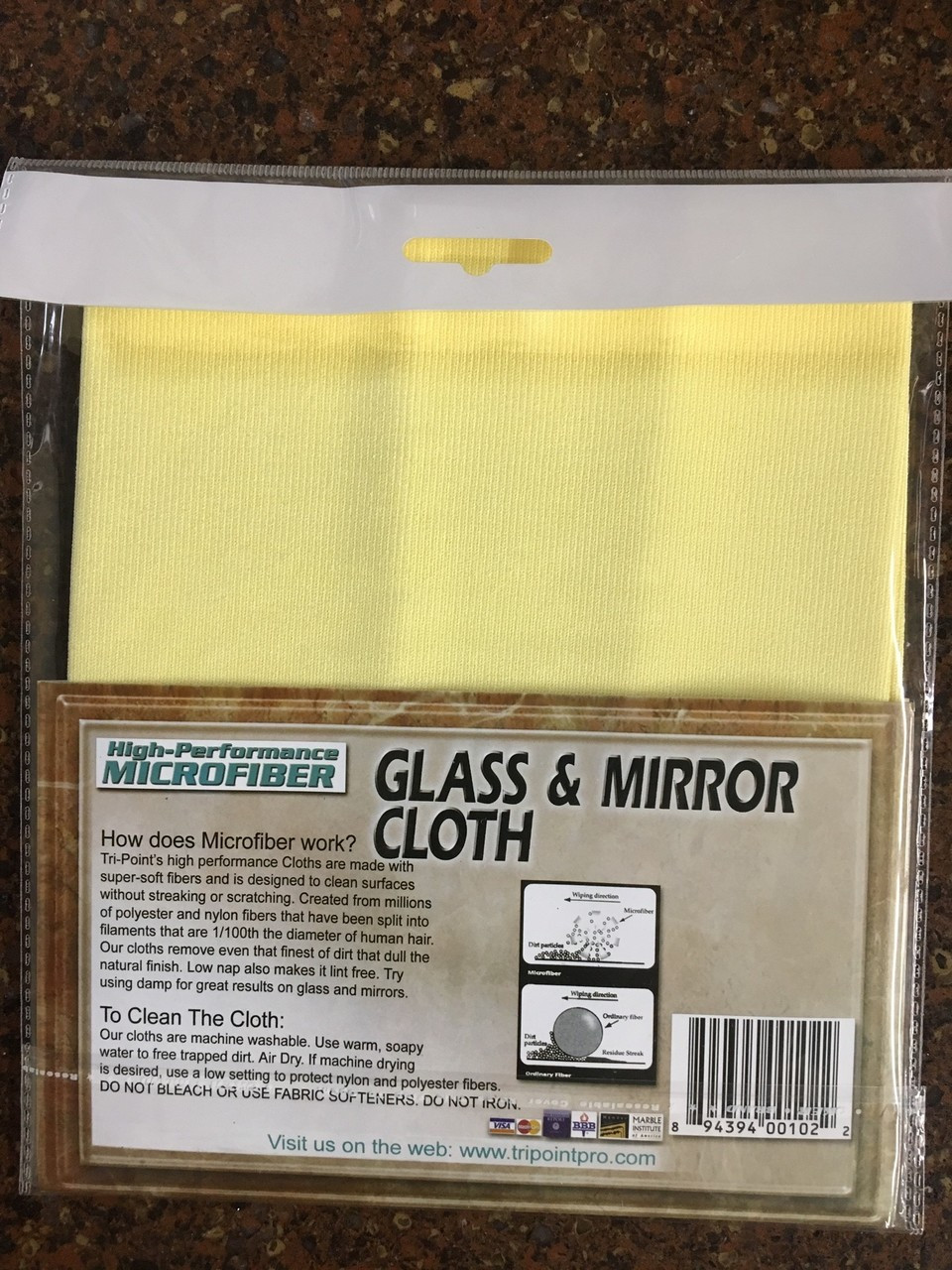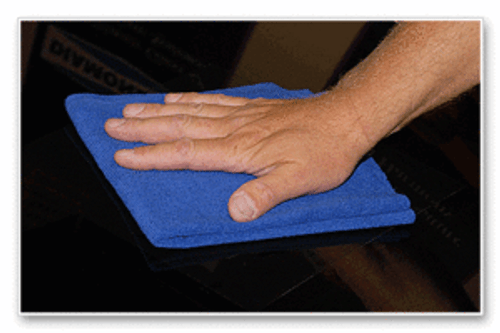Product Description
Micro Fiber Cleaning Cloth Made Specifically For Glass & Mirrors. Low nap also makes it lint free. Use damp with just warm water for great results.
(Yellow) 16"X16"
It has been said that microfiber technology is arguably the most significant product innovation to the cleaning industry in the last century. Not only has microfiber proven to reduce time and energy on certain tasks, it is environmentally friendly and rarely requires the use of chemicals. Research has also shown that using microfiber may reduce the potential for back, shoulder and elbow injuries, limiting workmans compensation claims. Those who are reluctant to change from their traditional cotton cloths and mops that need to be trained on the benefits of microfiber.
At first glance, the microfiber cloth appears to be no different than other cotton cloths. Both have similar thickness and feel, but when comparing the two its apparent that microfiber may be a step ahead of its cotton counterparts. The major difference between microfiber and cotton cloths is that microfiber strands are so small the human eye can barely see them. Microfiber is a synthetic fiber made up of a blend of polyester and polyamide or nylon. These materials are bundled together to form a strand that when examined under a microscope appears in the shape of a star. Those bundles are then split into ultra-fine single fibers using a specific combination of chemicals, heat and agitation. The fibers are finally woven together to make the finished microfiber product.
Research shows that it is the amount of splits that determines the quality of the microfiber. The splitting process breaks down each fiber into a very thin strand, estimated to be at least one-sixteenth the size of a human hair. When woven together these strands create a surface area covered with millions of spaces between the fibers to trap moisture, dirt and debris. (See diagram above.) The strands curled ends will also reach into cracks and crevices, picking up and removing dirt, holding it inside the pad. Traditional cleaning tools such as rope mops and cloths wont reach into these crevices, but will instead push the dirt around. Research has also shown that static charge aids in the effectiveness of microfiber cleaning. The millions of fibers rubbing together produce a static charge that attracts the dirt, pulling it in and trapping it until the cloth or pads are washed, at which time the charge is broken and the dirt is released.
Health care facilities have been quick to embrace this newer technology. In an effort to reduce cross contamination between patient rooms, some state laws require that housekeeping departments change out the mop and/or chemicals and water after every room. Using microfiber flat mops, this requirement isnt difficult to meet. Because flat mops are smaller and lighter (roughly three pounds when wet) than traditional string mops (between eight and 10 pounds when wet), more mops can be carried on carts and easily changed between rooms. Pushing and lifting less weight with the microfiber flat mops has also proven to reduce worker injury. Some argue that the microfiber flat mop is not only more ergonomic and productive, but cleans better overall. String mops create a lot of splattering on baseboards and very little grout cleaning. String mops push the water into the grout while the microfiber flat mops looped fibers grab and drag the dirt out. In addition to cleaning floors, flat mops can be used on walls and ceilings. Microfiber cloths and mitts have been developed for smaller surfaces such as counters, windows and mirrors. Wherever you would use a mop or rag, you could successfully substitute microfiber technology.
Microfiber is so versatile, some manufacturers have expanded their product line to include microfiber scrubbers, general purpose, soft cloths, etc., to target specific tasks. Users should be aware of the variety of microfiber products on the market, and understand that not all can be used for every application. For example, if a scrubbing cloth were used on a plastic finish, the cloth may scratch the surface. A soft cloth should be used in this situation. Manufacturer guidelines will help users identify and avoid these trouble areas.
The life expectancy of a microfiber product will depend on a number of factors. The first is the quality of microfiber composition that is used. The care that is given to the cleaning and storage of the product will also affect its life span. If cared for properly, microfiber can be laundered anywhere from 100 to 500 times. According to some manufacturers, the product itself will fall apart long before the microfiber becomes ineffective. Of course, this is assuming that the product is properly used and cared for. When using microfiber, there are very few applications that require the use of chemicals. Studies show that because of its technology, microfiber will clean more effectively when used dry than traditional products do when using chemicals. In situations where chemicals are required, manufacturers have come up with a few recommendations for combining the two: Dampen the pad or cloth before using it, but do not wet it, If too much water or chemical is used, the crevices that are designed to attract and hold dirt will fill with liquid. Very few chemicals can harm microfiber, but it is important to stay away from acids. Watch for warning labels. If the chemical indicates that it will harm plastics, it will most likely harm microfiber. Regardless of the use of chemicals, the laundering of microfiber products will also impact its life span. Laundering microfiber isnt much different than washing other cleaning products. As long as detergents have an overall pH of under 11, which is standard in most detergents, any soaps can be used in the cleaning process. While washing, steer clear of harsh bleaches, which will break down the fibers and hinder the microfibers effectiveness. It is important also to remember that microfiber should be washed in temperatures that do not exceed 200 degrees, for drying, you want a temperature between 130 and 140 degrees, max. Temperatures higher than these could potentially harm the product. Once detergent and temperature are determined, it is important to be conscious of what other products are included in the wash load. Although there are no restrictions as to what can and cant be washed with microfiber, there are best practice recommendations. One common mistake is to wash microfiber with products that are prone to lint,If this happens, the microfiber will continue working in the laundry and will collect that lint, making the cleaning process ineffective. Fabric softener will have a similar effect. Microfiber may collect particles from the softener sheet, clogging up the crevices in the cloth. Softeners might also reduce and possibly eliminate the static charge that makes microfiber effective.
The initial cost of microfiber products may be higher than what many departments are prepared to pay, but manufacturers guarantee significant savings over time. Before implementing a program, it is important for departments to consider life-cycle savings, reduction in chemical purchases, water bills, laundry services and reduced labor costs. Comparing current expenses to costs associated with microfiber will give departments a good idea of long-term savings. It is also important to consider the fact that housekeeping departments are constantly being asked to do more with less. Products such as microfiber will help staff productivity and efficiency saving time and money in the long run. Many manufacturers will work with housekeeping departments to figure out the estimated cost savings, as well as how to implement the new system. Although there is still some resistance among members of the housekeeping industry, microfiber technology continues to gain momentum. Industry sources expect that as more information becomes available, microfibers product offerings will expand well beyond the existing cloths, mitts and flat mops. In fact, some manufacturers are already in the planning phase for new applications to be released this year.









